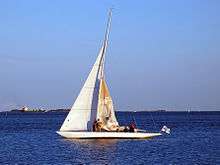Sailing

Sailing comprises wind propulsion of a craft by means of sails or other airfoils and steering it over water, ice or land, depending on the type of craft. A sailor manages the force of the wind on the sails by adjusting their angle with respect to the moving sailing craft and sometimes by adjusting the sail area. The force transmitted from the sails is resisted by forces from the hull, keel, and rudder of a sailing craft, by forces from skate runners for an iceboat, and by forces from wheels for a land sailing craft to allow steering a course on a point of sail with respect to the true wind.
While there are still some places in the world where sail-powered passenger, fishing and trading vessels are used, these craft have become rarer as internal combustion engines have become economically viable in even the poorest and most remote areas. In most countries sailing is enjoyed as a recreational activity or as a sport. Recreational sailing or yachting can be divided into racing and cruising. Cruising can include extended offshore and ocean-crossing trips, coastal sailing within sight of land, and daysailing.
History
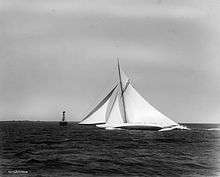
Throughout history sailing has been instrumental in the development of civilization, affording humanity greater mobility than travel over land, whether for trade, transport or warfare, and the capacity for fishing. The earliest representation of a ship under sail appears on a painted disc found in Kuwait dating between 5000 and 5500 BCE.[1] Polynesian oceanfarers traveled vast distances of open ocean in outrigger canoes using navigation methods such as stick charts.[2] Advances in sailing technology from the Middle Ages onward enabled Arab, Chinese, Indian and European explorers to make longer voyages into regions with extreme weather and climatic conditions. There were improvements in sails, masts and rigging; improvements in marine navigation including the cross tree and charts, of both the sea and constellations, allowed more certainty in sea travel. From the 15th century onwards, European ships went further north, stayed longer on the Grand Banks and in the Gulf of St. Lawrence, and eventually began to explore the Pacific Northwest and the Western Arctic.[3] Sailing has contributed to many great explorations in the world.
Physics
Introduction
The air interacting with the sails of a sailing vessel creates various forces, including reaction forces. If the sails are properly oriented with respect to the wind, then the net force on the sails will move the vessel forward.[4] However, boats propelled by sails cannot sail directly into the wind. They must tack (turn the boat through the eye of the wind) back and forth in order to progress directly upwind (see below "Beating").
Sails as airfoils
Sails are airfoils that work by using an airflow set up by the wind and the motion of the boat.[5][6][7] Sails work in two "modes" to use the wind to generate force (see Forces on sails):
- PUSH: when the boat is going in the same direction as the wind, the wind force simply pushes on the sail. The force on the sail is mostly aerodynamic drag, and sails acting in this way are aerodynamically stalled.[8]
- PULL: when the boat is traveling across the wind, the air coming in from the side is redirected toward the rear; according to Newton's Third law, the air is accelerated towards the rear of the boat and the sails experience a force in the opposite direction. This force manifests itself as pressure differences between the two sides of the sail - there is a region of low pressure on the front side of the sail and a region of high pressure on the back.[9] Another way to say this is that sails generate lift using the air that flows around them in the same way as an aircraft wing.[7] The wind flowing over the surface of the sail creates a force approximately perpendicular to the sail; the component of that force parallel to the boat's keel pulls the boat forward, the component perpendicular to the keel makes the boat heel and causes leeway.
Apparent wind
The wind that a boat experiences is the combination of the true wind (i.e. the wind relative to a stationary object) and the wind that occurs due to the forward motion of the boat. This combination is the apparent wind, which is the relative velocity of the wind relative to the boat.
When sailing upwind the apparent wind is greater than the true wind and the direction of the apparent wind will be forward of the true wind. Some high-performance boats are capable of traveling faster than the true windspeed on some points of sail, see for example the Hydroptère, which set a world speed record in 2009 by sailing 1.71 times the speed of the wind.[10][11] Iceboats can typically sail at 5 times the speed of the wind.[12]
The energy that drives a sailboat is harnessed by manipulating the relative movement of wind and water speed: if there is no difference in movement, such as on a calm day or when the wind and water current are moving in the same direction at the same speed, there is no energy to be extracted and the sailboat will not be able to do anything but drift. Where there is a difference in motion, then there is energy to be extracted at the interface. The sailboat does this by placing the sail(s) in the air and the hull(s) in the water.
A sailing vessel is not maneuverable due to sails alone—the forces caused by the wind on the sails would cause the vessel to rotate and travel sideways instead of moving forward. In the same manner that an aircraft requires stabilizers, such as a tailplane with elevators as well as wings, a boat requires a keel and rudder. The forces on the sails as well as those from below the water line on the keel, centreboard, and other underwater foils including the hull itself (especially for catamarans or in a traditional proa) combine and partially cancel each other to produce the motive force for the vessel. Thus, the physical portion of the boat that is below water can be regarded as functioning as a "second sail." The flow of water over the underwater hull portions creates hydrodynamic forces, which combine with the aerodynamic forces from the sails to allow motion in almost any direction except straight into the wind.[13] When sailing close to the wind the force generated by the sail acts at 90° to the sail. This force can be considered as split into a small force acting in the direction of travel, as well as a large sideways force that heels (tips) the boat. To enable maximum forward speed, the force needs to be cancelled out, perhaps using human ballast, leaving only a smaller forward resultant force. Depending on the efficiency of the rig and hull, the angle of travel relative to the true wind can be as little as 35° or may need to be 80° or greater. This angle is half of the tacking angle and defines one side of a 'no-go zone' into the wind, in which a vessel cannot sail directly.[14]
Tacking is essential when sailing upwind. The sails, when correctly adjusted, will generate aerodynamic lift. When sailing downwind, the sails no longer generate aerodynamic lift and airflow is stalled, with the wind push on the sails giving drag only. As the boat is going downwind, the apparent wind is less than the true wind and this, allied to the fact that the sails are not producing aerodynamic lift, serves to limit the downwind speed.[15]
Effects of wind shear
Wind shear affects sailboats in motion by presenting a different wind speed and direction at different heights along the mast. Wind shear occurs because of friction above a water surface slowing the flow of air. Thus, a difference in true wind creates a different apparent wind at different heights. Sailmakers may introduce sail twist in the design of the sail, where the head of the sail is set at a different angle of attack from the foot of the sail in order to change the lift distribution with height. The effect of wind shear can be factored into the selection of twist in the sail design, but this can be difficult to predict since wind shear may vary widely in different weather conditions. Sailors may also adjust the trim of the sail to account for wind gradient, for example, using a boom vang.[16]
Points of sail
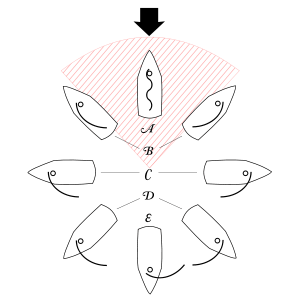
The point of sail describes a sailing boat's course in relation to the wind direction.
No sailboat can sail directly into the wind (known as being "in irons"), and for a given boat there is a minimum angle that it can sail relative to the wind; attempting to sail closer than that leads to the sails luffing and the boat will slow down and stop. This "no-go zone" (shown shaded in accompanying figure) is about 45° either side of the true wind for a modern sloop.
There are 5 main points of sail. In order from the edge of the no-go zone (or "irons") to directly downwind they are:
- close haul (the minimum angle to the wind that the boat and its rig can manage - typically about 45° )
- close reach (between close hauled and a beam reach)
- beam reach (approximately 90° to the wind)
- broad reach (between a beam reach and running)
- running (close to directly downwind)
The sail trim on a boat is relative to the point of sail one is on: on a beam reach sails are mostly let out, on a run sails are all the way out, and close hauled sails are pulled in very tightly. Two main skills of sailing are trimming the sails correctly for the direction and strength of the wind, and maintaining a course relative to the wind that suits the sails once trimmed.
Close Hauled or "Beating"
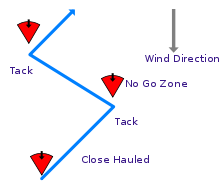
A boat can be 'worked to windward', to arrive at an upwind destination, by sailing close-hauled with the wind coming from one side, then tacking (turning the boat through the eye of the wind) and sailing with the wind coming from the other side. By this method of zig-zagging into the wind, known as beating, it is possible to reach any upwind destination.[13] A yacht beating to a mark directly upwind one mile away will cover a distance through the water of at least 1.4 miles, if it can tack through an angle of 90 degrees including leeway. An old adage describes beating as sailing for twice the distance at half the speed and three times the discomfort.[17]
An estimate of the correct tacking distance can be obtained (and thereby the time taken to travel it at various boat speeds) by using Pythagoras' theorem with equal tacks (assume a value of 1). This also assumes a tacking angle of 90°. The straight-line distance is the hypotenuse value of √2
When beating to windward one tack may be more favorable than the other - more in the desired direction. The best strategy is to stay on the favorable tack as much as possible. If the wind shifts in the sailor's favor, called a lift, so much the better, then this tack is even more favorable. But if it shifts against the sailor's, called a header, then the opposite tack may become the more favorable course. So when the destination is directly into the wind the best strategy is given by the racing adage "tack on a header." This is true because a header on one tack is a lift on the other.
How closely a boat can sail into the wind depends on the boat's design, sail shape and trim, the sea state, and the wind speed.
Typical minimum pointing angles to the true wind are as follows. Actual course over the ground will be worse due to leeway.
- about 35° for modern racing yachts which have been optimized for upwind performance (like America's Cup yachts)
- about 40 to 45° for modern cruiser-racer yachts (fast cruising yachts)
- about 50 to 60° for cruisers and work boats with inefficient keels, inefficient hull shapes, or low draught, when compared to craft designed for sailing performance, and for boats carrying two or more masts (since the forward sails adversely affect the windward ability of sails further aft when sailing upwind)
- around 80° for square riggers and similar vessels due to the sail shape which is relatively inefficient when sailing upwind

Sailing close-hauled under a large amount of sail, and heeling a great deal, can induce weather helm, or a tendency for the boat to turn into the wind. This requires pulling the tiller to windward (i.e. 'to weather'), or turning the wheel leeward, in order to counteract the effect and maintain the required course. The lee side of the hull is more under water than the weather side and the resulting shape of the submerged parts of the hull usually creates a force that pushes the bow to weather. Driving both the asymmetric heeling hull form and the angled rudder through the water produces drag that slows the boat down. If weather helm builds further, it can limit the ability of the helmsperson to steer the boat, which can be turned towards but not effectively away from the wind. At more extreme angles of heel, the boat will spontaneously 'round up' into the wind during gusts, i.e. it will turn into the wind regardless of any corrective action taken on the helm.
Any action that reduces the angle of heel of a boat that is reaching or beating to windward will help reduce excessive weather helm. Racing sailors use their body weight to bring the boat to a more upright position, but are not allowed to use "movable ballast" during a race.[18] Reducing or reefing the total sail area will have the same effect and many boats will sail faster with less sail in a stiff breeze due to the reduction in underwater drag. Easing the sheets on aft-most sails, such as the mainsail in a sloop or cutter can have an immediate effect, especially to help with maneuvering. Moving or increasing sail area forward can also help, for example by raising the jib (and maybe lowering the staysail) on a cutter. The actual design of the boat may be at fault. In this case adding a bow sprit, re-cutting the main sail, or moving the mast forward may all be part of the solution. Basically anything that moves the center of effort of the sails more forward will have the effect of reducing weather helm.
Reaching
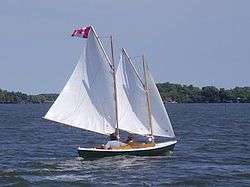
When the boat is traveling approximately perpendicular to the wind, this is called reaching. A beam reach is with the wind at right angles to the boat, a close reach is anywhere between beating and a beam reach, and a broad reach is between a beam reach and running.
For most modern sailboats, that is boats with fore-and-aft sails, reaching is the fastest way to travel. The direction of the wind is ideal when reaching because it can maximize the lift generated on the sails in the forward direction of the boat, giving the best boat speed. Also when reaching, the boat can be steered exactly in the direction that is most desirable, and the sails can be trimmed for that direction.
Reaching may, however, put the boat on a course parallel with the crests of the waves. When the waves are steep, it may be necessary to sail closer to the wind to avoid waves directly on the beam, which create the danger of capsizing.
Running
Steering a boat within roughly 30 degrees either side of dead downwind is called a run. This can be the most comfortable point of sail, but requires constant attention. When the wind is coming directly behind the boat, a fore-and-aft rigged vessel may sail wing on wing, one sail on port the other on starboard. Loss of attention by the helmsperson can lead to an accidental jibe, causing injury to the boat or crew. All on deck must be aware of, and if possible avoid, the potential arc of the boom, mainsheet and other gear in case an accidental jibe occurs during a run. A preventer can be rigged to reduce danger and damage from accidental jibes. Traditional sailing vessels with boomless or square sails are not put at risk by jibing.
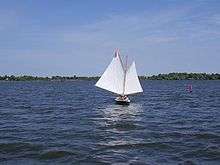
Another technique used while running is sailing by the lee. Here the main sail is placed on the windward side of the boat, leading to a heightened risk of gybing. With the main placed perpendicular to the boat to windward, and then pulled in slightly, the leech is allowed to act as the leading edge of an airfoil. (Usually, the luff is the leading edge, such as when close-hauled.) This position, though unstable to accidental gybes, allows the sail to generate some force from lift, just as when sailing on a broad-reach. In fact, because there is no mast to generate turbulence around the sail's leading edge (as happens on the broad reach) the lift generated is somewhat stronger than might be expected for such an oblique profile.
Another technique often used by cruisers is to set two head sails, one to port and one to starboard. Depending on the sails, this can often give as much sail area as a spinnaker, but is easier to control. It is also easier to handle than going wing and wing, as the main sail is not set and does not disturb the air flow to the head sails. The main boom then can be rigged as a whisker pole too, to stabilize one of the head sails.
Running is generally the most unstable point of sail for a fore-and-aft rigged vessel, but the easiest for a novice to grasp conceptually, making it a common downfall for beginners. In stronger winds, rolling increases as there is less rolling resistance provided by the sails, as they are eased out. Also, having the sails and boom(s) perpendicular to the boat throws weight and some wind force to that side, making the boat harder to balance. In smaller boats, death rolls can build up and lead to capsize.
Also on a run an inexperienced or inattentive sailor can easily misjudge the real wind strength since the boat speed subtracts directly from the true wind speed and makes the apparent wind less. In addition sea conditions can also falsely seem milder than they are as the waves ahead are being viewed from behind making white caps less apparent. When changing course from this point of sail to a reach or a beat, a sailboat that seemed under control can instantly become over-canvassed and in danger. Any boat over-canvassed on a run can round up, heel excessively and stop suddenly in the water. This is called broaching and it can lead to capsize, possible crew injury and loss of crew into the water.
Options for maneuvering are also reduced. On other points of sail, it is easy to stop or slow the boat by heading into the wind; there may be no such easy way out when running, especially in close quarters or when a spinnaker (including an Asymmetrical spinnaker), whisker pole or preventer are set.
Basic sailing techniques
Trim
An important aspect of sailing is keeping the boat in "trim".
- Course made good – The turning or steering of the boat vessel using the wheel or tiller to the desired course or buoy. See different points of sail. This may be a definite bearing (e.g. steer 270 degrees), or along a transit, or at a desired angle to the apparent wind direction.
- Trim – This is the fore and aft balance of the boat. The aim is to adjust the moveable ballast (the crew) forwards or backwards to achieve an 'even keel'. On an upwind course in a small boat, the crew typically sit forward to reduce drag. When 'running', it is more efficient for the crew to sit to the rear of the boat. The position of the crew matters less as the size (and weight) of the boat increases.
- Balance – This is the port and starboard balance. The aim, once again, is to adjust weight 'windward' or 'leeward' to prevent excessive heeling. The boat moves at a faster velocity if it is flat to the water.
- Sail trim – Sail trimming describes how a sail should be pulled in until it fills with wind, but no further than the point where the front edge of the sail (the luff) is exactly in line with the wind. Let it out until it starts to flap, and then pull it in until it stops.
- Centreboard (Daggerboard) – If a moveable centreboard is fitted, then it should be lowered when sailing "close to the wind" but can be raised on downwind courses to reduce drag. The centreboard prevents lateral motion and allows the boat to sail upwind. A boat with no centreboard will instead have a permanent keel, some other form of underwater foil, or even the hull itself which serves the same purpose. On a close haul the daggerboard should be fully down, and while running, over halfway up.
Together, these points are known as 'The Five Essentials' and constitute the central aspects of sailing.
Tacking and gybing
Tacking and gybing are converse ways to change from port tack to starboard tack (or vice versa): either by turning the bow through the eye of the wind, "tacking" or the stern, "jibing". In general sailing, tacking is the safer method and preferred especially when sailing upwind; in windsurfing, Jibing is preferred as this involves much less manoeuvring for the sailor.
For general sailing, during such course changes, there is work that needs to be done. Just before tacking the command "Ready about" is given, at which point the crew must man the sheet lines which need to be changed over to the other tack and the helmsperson gets ready. To execute the tack the command "Lee-ho" or "Hard-to-lee" is given. The latter is a direct order to the helmsperson to push the tiller hard to the leeward side of the boat making the bow of the boat come up and quickly turn through the eye of the wind to prevent the boat being caught in irons. As the boat turns through the eye of the wind, some sails such as those with a boom and a single sheet may self-tack and need only small adjustments of sheeting points, but for jibs and other sails with separate sheets on either side, the original sheet must be loosened and the opposite sheet lines hauled in and set quickly and properly for the new point of sail.
Jibing is often necessary to change course when sailing off the wind or downwind. It is a more dangerous manoeuvre because the boom has further to travel (because the sails are let further out to the side of the boat when travelling downwind) in the same amount of time and therefore must be controlled as the sails catch the new wind direction from astern. An uncontrolled jibe can happen suddenly by itself when sailing downwind if the helmsperson is not paying attention to the wind direction and can be very dangerous as the main boom will sweep across the cockpit very quickly and with great force. Before jibing the command "Ready to jibe" is given. The crew gets ready at their positions. If any sails are constrained with preventers or whisker poles these are taken down. The command "Jibe-ho" is given to execute the turn. The boomed sails must be hauled in and made fast before the stern reaches the eye of the wind, so that they are amidship and controlled as the stern passes through the eye of the wind, and then let out quickly under control and adjusted to the new point of sail.
The choice of which strategy to use (coming-about or jibing) depends on the conditions, sail configuration, and the craft. For light craft such as a Hobie Cat (which has little mass) coming into the wind should only be attempted when moving very quickly such as >8 knots. Of course this happens under strong wind. The timing of the crew shift is also critical when coming into the wind. If in light wind, a jibe is the better choice as there's less danger of the wind tipping the boat. A phrase to help remember this is: "light jibe, hard tack" (light/hard referring to wind strength) Of course being caught in irons near shore/structures in strong wind can be catastrophic.
Reducing sail (reefing)
An important safety aspect of sailing is to adjust the amount of sail to suit the wind conditions. As the wind speed increases the crew should progressively reduce the amount of sail. On a small boat with only jib and mainsail this is done by furling the jib and by partially lowering the mainsail, a process called 'reefing the main'.
Reefing means reducing the area of a sail without actually changing it for a smaller sail. Ideally reefing does not only result in a reduced sail area but also in a lower centre of effort from the sails, reducing the heeling moment and keeping the boat more upright.
There are three common methods of reefing the mainsail:
- Slab reefing, which involves lowering the sail by about one-quarter to one-third of its full length and tightening the lower part of the sail using an outhaul or a pre-loaded reef line through a cringle at the new clew, and hook through a cringle at the new tack.
- In-mast (or on-mast) roller-reefing. This method rolls the sail up around a vertical foil either inside a slot in the mast, or affixed to the outside of the mast. It requires a mainsail with either no battens, or newly developed vertical battens.
- In-boom roller-reefing, with a horizontal foil inside the boom. This method allows for standard- or full-length horizontal battens.
Mainsail furling systems have become increasingly popular on cruising yachts, as they can be operated shorthanded and from the cockpit, in most cases. However, the sail can become jammed in the mast or boom slot if not operated correctly. Mainsail furling is almost never used while racing because it results in a less efficient sail profile. The classical slab-reefing method is the most widely used. Mainsail furling has an additional disadvantage in that its complicated gear may somewhat increase weight aloft. However, as the size of the boat increases, the benefits of mainsail roller furling increase dramatically.
An old saying goes, “Once you’ve realized it’s time to reef, it’s too late.” A similar one says, "The time to reef is when you first think about it."[19]
Sail trimming
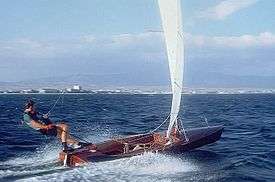
The most basic control of the sail consists of setting its angle relative to the wind. The control line that accomplishes this is called a "sheet." If the sheet is too loose the sail will flap in the wind, an occurrence that is called "luffing." Optimum sail angle can be approximated by pulling the sheet in just so far as to make the luffing stop, or by using of tell-tales - small ribbons or yarn attached each side of the sail that both stream horizontally to indicate a properly trimmed sail.[20] Finer controls adjust the overall shape of the sail.
Two or more sails are frequently combined to maximize the smooth flow of air. The sails are adjusted to create a smooth laminar flow over the sail surfaces. This is called the "slot effect". The combined sails fit into an imaginary aerofoil outline, so that the most forward sails are more in line with the wind, whereas the more aft sails are more in line with the course followed. The combined efficiency of this sail plan is greater than the sum of each sail used in isolation.
More detailed aspects include specific control of the sail's shape, e.g.:
- reefing, or reducing the sail area in stronger wind
- altering sail shape to make it flatter in high winds
- raking the mast when going upwind (to tilt the sail towards the rear, this being more stable)
- providing sail twist to account for wind speed differential and to spill excess wind in gusty conditions
- gibbing or lowering a sail
Hull trim
Hull trim is the adjustment of a boat's loading so as to change its fore-and-aft attitude in the water. In small boats, it is done by positioning the crew. In larger boats the weight of a person has less effect on the hull trim, but it can be adjusted by shifting gear, fuel, water, or supplies. Different hull trim efforts are required for different kinds of boats and different conditions. Here are just a few examples: In a lightweight racing dinghy like a Thistle, the hull should be kept level, on its designed water line for best performance in all conditions. In many small boats, weight too far aft can cause drag by submerging the transom, especially in light to moderate winds. Weight too far forward can cause the bow to dig into the waves. In heavy winds, a boat with its bow too low may capsize by pitching forward over its bow (pitch-pole) or dive under the waves (submarine). On a run in heavy winds, the forces on the sails tend to drive a boat's bow down, so the crew weight is moved far aft.
Heeling
When a ship or boat leans over to one side, from the action of waves or from the centrifugal force of a turn or under wind pressure or from amount of exposed topsides, it is said to 'heel'. A sailing boat that is over-canvassed and therefore heeling excessively, may sail less efficiently. This is caused by factors such as wind gusts, crew ability, the point of sail, or hull size & design.
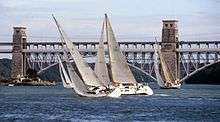
When a vessel is subject to a heeling force (such as wind pressure), vessel buoyancy & beam of the hull will counter-act the heeling force. A weighted keel provides additional means to right the boat. In some high-performance racing yachts, water ballast or the angle of a canting keel can be changed to provide additional righting force to counteract heeling. The crew may move their personal weight to the high (upwind) side of the boat, this is called hiking, which also changes the centre of gravity & produces a righting lever to reduce the degree of heeling. Incidental benefits include faster vessel speed caused by more efficient action of the hull & sails. Other options to reduce heeling include reducing exposed sail area & efficiency of the sail setting & a variant of hiking called "trapezing". This can only be done if the vessel is designed for this, as in dinghy sailing. A sailor can (usually involuntarily) try turning upwind in gusts (it is known as rounding up). This can lead to difficulties in controlling the vessel if over-canvassed. Wind can be spilled from the sails by 'sheeting out', or loosening them. The number of sails, their size and shape can be altered. Raising the dinghy centreboard can reduce heeling by allowing more leeway.
The increasingly asymmetric underwater shape of the hull matching the increasing angle of heel may generate an increasing directional turning force into the wind. The sails' centre of effort will also increase this turning effect or force on the vessel's motion due to increasing lever effect with increased heeling which shows itself as increased human effort required to steer a straight course. Increased heeling reduces exposed sail area relative to the wind direction, so leading to an equilibrium state. As more heeling force causes more heel, weather helm may be experienced. This condition has a braking effect on the vessel but has the safety effect in that an excessively hard pressed boat will try and turn into the wind therefore reducing the forces on the sail. Small amounts (≤5 degrees) of weather helm are generally considered desirable because of the consequent aerofoil lift effect from the rudder. This aerofoil lift produces helpful motion to windward & the corollary of the reason why lee helm is dangerous. Lee helm, the opposite of weather helm, is generally considered to be dangerous because the vessel turns away from the wind when the helm is released, thus increasing forces on the sail at a time when the helmsperson is not in control.
Sailing hulls and hull shapes
Sailing boats with one hull are "monohulls", those with two are "catamarans", those with three are "trimarans". A boat is turned by a rudder, which itself is controlled by a tiller or a wheel, while at the same time adjusting the sheeting angle of the sails. Smaller sailing boats often have a stabilizing, raisable, underwater fin called a centreboard, daggerboard, or leeboard; larger sailing boats have a fixed (or sometimes canting) keel. As a general rule, the former are called dinghies, the latter keelboats. However, up until the adoption of the Racing Rules of Sailing, any vessel racing under sail was considered a yacht, be it a multi-masted ship-rigged vessel (such as a sailing frigate), a sailboard (more commonly referred to as a windsurfer) or remote-controlled boat, or anything in between. (See Dinghy sailing.)
Multihulls use flotation and/or weight positioned away from the centre line of the sailboat to counter the force of the wind. This is in contrast to heavy ballast that can account for up to 90% (in extreme cases like AC boats) of the weight of a monohull sailboat. In the case of a standard catamaran, there are two similarly-sized and -shaped slender hulls connected by beams, which are sometimes overlaid by a deck superstructure. Another catamaran variation is the proa. In the case of trimarans, which have an unballasted centre hull similar to a monohull, two smaller amas are situated parallel to the centre hull to resist the sideways force of the wind. The advantage of multihulled sailboats is that they do not suffer the performance penalty of having to carry heavy ballast, and their relatively lesser draft reduces the amount of drag, caused by friction and inertia, when moving through the water.
One of the most common dinghy hulls in the world is the Laser hull. It was designed by Bruce Kirby in 1969 and unveiled at the New York boat show (1971). It was designed with speed and simplicity in mind. The Laser is 13 feet 10.5 inches long and a 12.5 foot water line and 76 square feet (7.1 m2) of sail.
Types of sails and layouts

A traditional modern yacht is technically called a "Bermuda sloop" (sometimes a "Bermudan sloop"). A sloop is any boat that has a single mast and usually a single headsail (generally a jib) in addition to the mainsail (Bermuda rig but c.f. Friendship sloop). A cutter (boat) also has a single mast, set further aft than a sloop and more than one headsail. Additionally, Bermuda sloops only have a single sail behind the mast. Other types of sloops are gaff-rigged sloops and lateen sloops. Gaff-rigged sloops have quadrilateral mainsails with a gaff (a small boom) at their upper edge (the "head" of the sail). Gaff-rigged vessels may also have another sail, called a topsail, above the gaff. Lateen sloops have triangular sails with the upper edge attached to a gaff, and the lower edge attached to the boom, and the boom and gaff are attached to each other via some type of hinge. It is also possible for a sloop to be square rigged (having large square sails like a Napoleonic Wars-era ship of the line). Note that a "sloop of war", in the naval sense, may well have more than one mast, and is not properly a sloop by the modern meaning.
If a boat has two masts, it may be a schooner, a ketch, or a yawl, if it is rigged fore-and-aft on all masts. A schooner may have any number of masts provided the second from the front is the tallest (called the "main mast"). In both a ketch and a yawl, the foremost mast is tallest, and thus the main mast, while the rear mast is shorter, and called the mizzen mast. The difference between a ketch and a yawl is that in a ketch, the mizzen mast is forward of the rudderpost (the axis of rotation for the rudder), while a yawl has its mizzen mast behind the rudderpost. In modern parlance, a brigantine is a vessel whose forward mast is rigged with square sails, while her after mast is rigged fore-and-aft. A brig is a vessel with two masts both rigged square.
As one gets into three or more masts the number of combinations rises and one gets barques, barquentines, and full rigged ships.
A spinnaker is a large, full sail that is only used when sailing off wind either reaching or downwind, to catch the maximum amount of wind.
Rigid foils
With modern technology, "wings", that is rigid sails, may be used in place of fabric sails. An example of this would be the International C-Class Catamaran Championship and the yacht USA 17 that won the 2010 America's Cup.[21] Such rigid sails are typically made of thin plastic fabric held stretched over a frame.[21] See also AC72 wing-sail catamarans which competed in the 2013 America's Cup.
Alternative wind-powered vessels
Some non-traditional rigs capture energy from the wind in a different fashion and are capable of feats that traditional rigs are not, such as sailing directly into the wind. One such example is the wind turbine boat, also called the windmill boat,[22] which uses a large windmill to extract energy from the wind, and a propeller to convert this energy to forward motion of the hull. A similar design, called the autogyro boat, uses a wind turbine without the propellor, and functions in a manner similar to a normal sail.[23] A more recent (2010) development is a cart that uses wheels linked to a propeller to "sail" dead downwind at speeds exceeding wind speed.[24][25]
Kites and pivoting spars
Some sailing craft are propelled by kites, as with kitesurfing, which uses a tethered airfoil. Others use an airfoil on a pivoting spar, as with windsurfers. Both forms of sailing may employ the airfoil in a manner that provides an upward force, as well as a propulsive one, when the sailor controls the airfoil atop a planing board with a skeg.
Sailing terminology
Sailors use traditional nautical terms for the parts of or directions on a vessel: starboard (right), port or larboard (left), forward or fore (front), aft or abaft (rearward), bow (forward part of the hull), stern (aft part of the hull), beam (the widest part). Vertical spars are masts, horizontal spars are booms (if they can hit the sailor), yards, gaffs (if they are too high to reach) or poles (if they cannot hit the sailor).[26]
Rope and lines
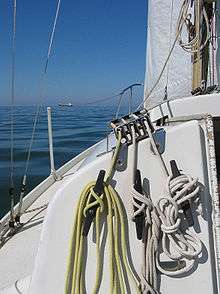
In most cases, rope is the term used only for raw material. Once a section of rope is designated for a particular purpose on a vessel, it generally is called a line, as in outhaul line or dock line. A very thick line is considered a cable. Lines that are attached to sails to control their shapes are called sheets, as in mainsheet. If a rope is made of wire, it maintains its rope name as in 'wire rope' halyard.
Lines (generally steel cables) that support masts are stationary and are collectively known as a vessel's standing rigging, and individually as shrouds or stays. The stay running forward from a mast to the bow is called the forestay or headstay. Stays running aft are backstays or after stays.
Moveable lines that control sails or other equipment are known collectively as a vessel's running rigging. Lines that raise sails are called halyards while those that strike them are called downhauls. Lines that adjust (trim) the sails are called sheets. These are often referred to using the name of the sail they control (such as main sheet, or jib sheet). Sail trim may also be controlled with smaller lines attached to the forward section of a boom such as a cunningham; a line used to hold the boom down is called a vang, or a kicker in the United Kingdom. A topping lift is used to hold a boom up in the absence of sail tension. Guys are used to control the ends of other spars such as spinnaker poles.
Lines used to tie a boat up when alongside are called docklines, docking cables or mooring warps. In dinghies the single line from the bow is referred to as the painter. A rode is what attaches an anchored boat to its anchor. It may be made of chain, rope, or a combination of the two.
Some lines are referred to as ropes:
- a bell rope (to ring the bell),
- a bolt rope (attached to the edge of a sail for extra strength),
- a foot rope (for sailors on square riggers to stand on while reefing or furling the sails), and
- a tiller rope (to temporarily hold the tiller and keep the boat on course).
Other terms

Walls are called bulkheads or ceilings, while the surfaces referred to as ceilings on land are called overheads or deckheads. Floors are called soles or decks. The toilet is traditionally called the head, the kitchen is the galley. When lines are tied off, this may be referred to as made fast or belayed. Sails in different sail plans have unchanging names, however. For the naming of sails, see sail-plan.
Knots and line handling
The tying and untying of knots and hitches as well as the general handling of ropes and lines are fundamental to the art of sailing.[27] The RYA basic 'Start Yachting' syllabus lists the following knots and hitches:
- figure-eight knot — stopper knot
- round turn and two half hitches — secure the end of a rope to a fixed object
- bowline — used to form a fixed loop at the end of a rope
It also lists securing a line around a cleat and the use of winches and jamming cleats.[28]
The RYA Competent Crew syllabus adds the following to the list above, as well as knowledge of the correct use of each:
- clove hitch — securing lines running along a series of posts
- rolling hitch — rigging a stopper to relax the tension on a sheet
- reef knot — joining two ends of a single line to bind around an object
- single and double sheet bend — joining two ropes of different diameters
In addition it requires competent crewmembers to understand 'taking a turn' around a cleat and to be able to make cleated lines secure. Lines and halyards need to be coiled neatly for stowage and reuse. Dock lines need to be thrown and handled safely and correctly when coming alongside, up to a buoy, and when anchoring, as well as when casting off and getting under way.[29]
Rules and regulations
Every vessel in coastal and offshore waters is subject to the International Regulations for Preventing Collisions at Sea (the COLREGS). On inland waterways and lakes other similar regulations, such as CEVNI in Europe, may apply. In some sailing events, such as the Olympic Games, which are held on closed courses where no other boating is allowed, specific racing rules such as the Racing Rules of Sailing (RRS) may apply. Often, in club racing, specific club racing rules, perhaps based on RRS, may be superimposed onto the more general regulations such as COLREGS or CEVNI.
In general, regardless of the activity, every sailor must
- Maintain a proper lookout at all times
- Adjust speed to suit the conditions
- Know whether to 'stand on' or 'give way' in any close-quarters situation.[30]
The stand-on vessel must hold a steady course and speed but be prepared to take late avoiding action to prevent an actual collision if the other vessel does not do so in time. The give-way vessel must take early, positive and obvious avoiding action, without crossing ahead of the other vessel. (Rules 16-17)
- If an approaching vessel remains on a steady bearing, and the range is decreasing, then a collision is likely. (Rule 7) This can be checked with a hand-bearing compass.
- The sailing vessel on port tack[31] gives way to the sailing vessel on starboard tack[32] (Rule 12)
- If both sailing vessels are on the same tack, the windward boat gives way to the leeward one (Rule 12)
- If a vessel on port tack is unable to determine the tack of the other boat, she should be prepared to give way (Rule 12)
- An overtaking vessel must keep clear of the vessel being overtaken (Rule 13)
- Sailing vessels must give way to vessels engaged in fishing, those not under command, those restricted in their ability to manoeuvre and should avoid impeding the safe passage of a vessel constrained by her draft. (Rule 18)
The COLREGS go on to describe the lights to be shown by vessels under way at night or in restricted visibility. Specifically, for sailing boats, red and green sidelights and a white sternlight are required, although for vessels under 7 metres (23.0 ft) in length, these may be substituted by a torch or white all-round lantern. (Rules 22 & 25)
Sailors are required to be aware not only of the requirements for their own boat, but of all the other lights, shapes and flags that may be shown by other vessels, such as those fishing, towing, dredging, diving etc., as well as sound signals that may be made in restricted visibility and at close quarters, so that they can make decisions under the COLREGS in good time, should the need arise. (Rules 32-37)
In addition to the COLREGS, CEVNI and/or any specific racing rules that apply to a sailing boat, there are also
- The IALA International Association of Lighthouse Authorities standards for lateral marks, lights, signals, and buoyage and rules designed to support safe navigation.
- The SOLAS (International Convention for the Safety of Life at Sea) regulations, specifically Chapter V, which became mandatory for all leisure craft users of the sea from 1 July 2002.[33] These regulations place the obligations for safety on the owners and operators of any boat including sailboats. They specify the safety equipment needed, the emergency procedures to be used appropriate to the boat's size and its sailing range, and requirements for passage planning with regard to weather and safety.
Licensing
Licensing regulations vary widely across the world. While boating on international waters does not require any license, a license may be required to operate a vessel on coastal waters or inland waters. Some jurisdictions require a license when a certain size is exceeded (e.g., a length of 20 meters), others only require licenses to pilot passenger ships, ferries or tugboats. For example, the European Union issues the International Certificate of Competence, which is required to operate pleasure craft in most inland waterways within the union. The United States in contrast has no licensing, but instead has voluntary certification organizations such as the American Sailing Association.[34] These US certificates are often required to charter a boat, but are not required by any federal or state law.
Sailboat racing

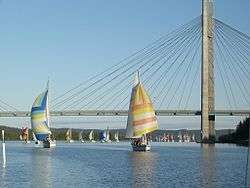
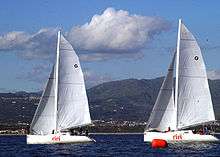
Sailboat racing generally fits into one of two categories:
Introduction
Sailing is a diverse sport with many pinnacles from the Olympic Games to many world championships titles to development based campaigns for the America's Cup to round the world races such as the Vendee Globe and Volvo Ocean Race.
Sailboat racing ranges from single person dinghy racing to large boats with 10 or more crew and from small boats costing a few thousand dollars to multimillion-dollar America's Cup campaigns. The costs of participating in the high end large boat competitions make this type of sailing one of the most expensive sports in the world. However, there are inexpensive ways to get involved in sailboat racing, such as at community sailing clubs, classes offered by local recreation organizations and in some inexpensive dinghy and small catamaran classes. Under these conditions, sailboat racing can be comparable to or less expensive than sports such as golf and skiing. Sailboat racing is one of the few sports in which people of all ages and genders can regularly compete with and against each other.
The sport of Sailboat racing is governed by the World Sailing with most racing formats using the Racing Rules of Sailing.
Competition Criteria
Sailing regatta contain events which are defined by a combination of discipline, equipment, gender and sailor categories.
- Equipment
Common categories of equipment include the following dinghies, multihulls, keelboats sailing yacht windsurfers, kiteboarding and radio-controlled sailboats.
- Disciplines
The following are the main disciplines:
- Fleet Racing – The commonest form of competitive sailing involving boats racing around a course.[35]
- Match Racing – Two identical boats race against each other. This is one-on-one duel requires strategy and tactics. The first to cross the finish line wins.[36]
- Team Racing – Two teams each of normally three boats compete against each other. Fast paced racing depends on excellent boat handling skills and rapid tactical decision making.[37]
- Speed Sailing - Is managed by World Speed Sailing Record Council
- Wave Riding
- Both windsurfing and kiteboarding are experimenting with new formats.
- Gender
The majority of sailing events are "open" events in which males and females compete together on equal terms either as individuals or part of team. Sailing has had female only World Championships since the 1970s to encourage participation and now host more than 30 such World Championship titles each year. While many mixed gender crews have competed in open events compulsory mixed gender are now included as events in both Olympic (Nacra 17) and Paralympic (SKUD 18).
- Sailor Categories
In addition the following categories are sometimes applied to events:
- Age
- Nationality
- Disabled Classification
- Professional Sailor Classification
Regatta
Most sailboat and yacht racing is done in coastal or inland waters. However, in terms of endurance and risk to life, ocean races such as the Volvo Ocean Race, the solo VELUX 5 Oceans Race, and the non-stop solo Vendée Globe, rate as some of the most extreme and dangerous sporting events. Not only do participants compete for days with little rest, but an unexpected storm, a single equipment failure, or collision with an ice floe could result in the sailboat being disabled or sunk hundreds or thousands of miles from search and rescue.
Equipment
- Handicap
- Where boats of different types sail against each other and are scored based on their handicaps which are calculated either before the start or after the finish. Most small boat racing is class racing or handicap racing under Portsmouth Yardstick. However most yacht racing is done under handicap the two international recognised systems are IRC, ORC Club and ORCi which are used for pinnacle events ( e.g. Fastnet Race, Commodore's Cup, Sydney to Hobart Yacht Race, Bermuda Race, etc.) Other empiracle handicap systems are also popular for example Performance Handicap Racing Fleet (PHRF) is very common in the U.S.A.
- Class
- Where all the boats are substantially similar, and the first boat to finish wins.
Class racing can be further subdivided in measurment controlled and manufacturer controlled classes.
Manufactuer controlled classes strictly control the production and source of equipment. (e.g. 29er, Laser,Farr 40, RS Feva, Soling, etc.)
However it is measurement controlled classes that offer the divercity in equipment. Some classes use measurement control to tighly control the boats as much as manufacturer class (e.g. , 470, Contender, Star etc.)
At the other end of the extreme are the development classes which freely allow development within a defined framework. These are most commonly either forumla based like the metre class or a box-rule that defines key criteria like maximum length, minimum weight, and maximum sail area. (e.g. Moth (dinghy), the A Class Catamaran, TP 52, and IMOCA 60.
Recreational sailing
Sailing for pleasure can involve short trips across a bay, day sailing, coastal cruising, and more extended offshore or 'blue-water' cruising. These trips can be singlehanded or the vessel may be crewed by families or groups of friends. Sailing vessels may proceed on their own, or be part of a flotilla with other like-minded voyagers. Sailing boats may be operated by their owners, who often also gain pleasure from maintaining and modifying their craft to suit their needs and taste, or may be rented for the specific trip or cruise. A professional skipper and even crew may be hired along with the boat in some cases. People take cruises in which they crew and 'learn the ropes' aboard craft such as tall ships, classic sailing vessels and restored working boats.
Cruising trips of several days or longer can involve a deep immersion in logistics, navigation, meteorology, local geography and history, fishing lore, sailing knowledge, general psychological coping, and serendipity. Once the boat is acquired it is not all that expensive an endeavor, often much less expensive than a normal vacation on land. It naturally develops self-reliance, responsibility, economy, and many other useful skills. Besides improving sailing skills, all the other normal needs of everyday living must also be addressed. There are work roles that can be done by everyone in the family to help contribute to an enjoyable outdoor adventure for all.
A style of casual coastal cruising called gunkholing is a popular summertime family recreational activity. It consists of taking a series of day sails to out of the way places and anchoring overnight while enjoying such activities as exploring isolated islands, swimming, fishing, etc. Many nearby local waters on rivers, bays, sounds, and coastlines can become great natural cruising grounds for this type of recreational sailing. Casual sailing trips with friends and family can become lifetime bonding experiences.
Passagemaking
Long-distance voyaging, such as that across oceans and between far-flung ports, can be considered the near-absolute province of the cruising sailboat. Most modern yachts of 25–55 feet long, propelled solely by mechanical powerplants, cannot carry the fuel sufficient for a point-to-point voyage of even 250–500 miles without needing to resupply; but a well-prepared sail-powered yacht of similar length is theoretically capable of sailing anywhere its crew is willing to guide it. Even considering that the cost benefits are offset by a much reduced cruising speed, many people traveling distances in small boats come to appreciate the more leisurely pace and increased time spent on the water.
Since the solo circumnavigation of Joshua Slocum in the 1890s, long-distance cruising under sail has inspired thousands of otherwise normal people to explore distant seas and horizons. The important voyages of Robin Lee Graham, Eric Hiscock, Don Street[38] and others have shown that, while not strictly racing, ocean voyaging carries with it an inherent sense of competition, especially that between man and the elements.
Such a challenging enterprise requires keen knowledge of sailing in general as well as maintenance, navigation (especially celestial navigation), and often even international diplomacy (for which an entire set of protocols should be learned and practiced). But one of the great benefits to sailboat ownership is that one may at least imagine the type of adventure that the average affordable powerboat could never accomplish.
See also
- American Sail Training Association
- Boat building
- Canadian Yachting Association
- Catboat and Sloop
- Day sailer
- Dinghy racing
- Glossary of nautical terms
- Ice boat
- Land sailing
- Marina
- Planing (boat)
- Puddle Duck Racer
- Racing Rules of Sailing
- Royal Yachting Association
- Sailing at the Summer Olympics
- Sailing faster than the wind
- Single-handed sailing
- Solar sail
- Tacking (sailing)
- Trailer sailer
- Turtling (sailing)
- U.S. intercollegiate sailing champions
- US Sailing
- Yacht charter
Notes
- ↑ Carter, Robert "Boat remains and maritime trade in the Persian Gulf during the sixth and fifth millennia BC"Antiquity Volume 80 No.307 March 2006
- ↑ O'Connor, Tom (September–October 2004). "Polynesians in the Southern Ocean: Occupation of the Aukland in Islands in Prehistory". New Zealand Geographic. 69 (6-8).
- ↑ "Transportation and Maps" in Virtual Vault, the art of the boat is an online exhibition of Canadian historical art at Library and Archives Canada
- ↑ Robert Stawell Ball (1871), Experimental Mechanics, §30 Sailing, page 21, from Google books
- ↑ "2.972 How A Sail Boat Sails Into The Wind". Web.mit.edu. Retrieved 2010-06-30.
- ↑ "The physics of sailing". Animations.physics.unsw.edu.au. Retrieved 2010-06-30.
- 1 2 "how a sail works @". Sailtheory.com. Retrieved 2010-06-30.
- ↑ "Introduction to Dinghy Sailing at the Cal Sailing Club" (PDF). Cal Sailing Club. Retrieved 25 February 2015.
- ↑ "The Physics of Sailing". University of New South Wales. University of New South Wales. Retrieved 25 February 2015.
- ↑ "WSSR Newsletter No 177. Hydroptere World Records. 23/09/09". Sailspeedrecords.com. 2009-09-04. Retrieved 2010-06-30.
- ↑ "l'Hydroptère". Hydroptere.com. Retrieved 2010-06-30.
- ↑ See "How fast do these things really go?" in the "FAQ published by the Four Lakes Ice Yacht Club".
- 1 2 How sail boats sail against the wind? Faster than the wind? http://PhysicsForArchitects.com/Sailing_against_the_wind.php
- ↑ "OZ PD Racer - Measuring Leeway and Tacking Angle - Michael Storer Boat Design". Storerboatplans.com. Retrieved 2010-06-30.
- ↑ Large sails of big area, spinnakers serve to increase the sail area for more performance downwind.
- ↑ Garrett, Ross (1996). The Symmetry of Sailing. Dobbs Ferry: Sheridan House. pp. 97–99. ISBN 1-57409-000-3.
- ↑ Each leg at 45 degrees to the true wind is 0.71 miles, but in reality is longer as total tacking angles greater than 90° are the norm and leeway can be significant
- ↑ http://www.sailing.org/documents/racing-rules.php, "51 MOVABLE BALLAST: All movable ballast, including sails that are not set, shall be properly stowed. Water, dead weight or ballast shall not be moved for the purpose of changing trim or stability. Floorboards, bulkheads, doors, stairs and water tanks shall be left in place and all cabin fixtures kept on board. However, bilge water may be bailed out."
- ↑ "Reefing is Important". American Sailing Association. Retrieved October 6, 2016.
- ↑ http://www.aclasssailing.co.nz/Sailing%20With%20A%20Smile.pdf
- 1 2 "c class catamarans". Sailmagazine.com. Retrieved 2010-06-30.
- ↑ "Windmill Sailboat: Sailing Against the Wind". TreeHugger. Retrieved 2010-06-30.
- ↑ WebCite query result
- ↑ Cort, Adam (April 5, 2010). "Running Faster than the Wind". sailmagazine.com. Retrieved April 6, 2010.
- ↑ "Ride Like the Wind (only faster)". Retrieved April 6, 2010.
- ↑ Rousmaniere, John (June 1998). The Illustrated Dictionary of Boating Terms: 2000 Essential Terms for Sailors and Powerboaters (Paperback). W. W. Norton & Company. p. 174. ISBN 978-0-393-33918-5. ISBN 0-393-33918-1. Retrieved 9 January 2014.
- ↑ Tom Lochhass. "Basic Sailing Knots". The New York Times Company. Retrieved 9 July 2012.
- ↑ Jinks, Simon (2007). RYA Sail Cruising and Yachtmaster Scheme: Syllabus and logbook. Eastleigh, Hampshire: Royal yachting Association. p. 10. ISBN 978-1-905104-98-7.
- ↑ Competent Crew: Practical Course Notes. Eastleigh, Hampshire: Royal Yachting Association. 1990. pp. 32–43. ISBN 0-901501-35-2.
- ↑ Pearson, Malcolm (2007). Reeds Skipper's Handbook. Adlard Coles Nautical. p. 95. ISBN 978-0-7136-8338-7.
- ↑ Sails set for a breeze coming from the left hand side of the boat
- ↑ Sails set for a breeze coming from the right side of the boat
- ↑ Pearson, Malcolm (2007). Reeds Skipper's Handbook. Adlard Coles Nautical. p. 115. ISBN 978-0-7136-8338-7.
- ↑ "ASA and US-Sailing Approved Sailing Schools in the USA". EduMaritime.com.
- ↑ "Fleet Racing". Sailing.org.
- ↑ "Match Racing". Sailing.org.
- ↑ "Team Racing". Sailing.org.
- ↑ Donald M. Street Jr. (14 May 2012). "Biography - Donald M. Street Jr.".
Bibliography
- "Transportation and Maps" in Virtual Vault, an online exhibition of Canadian historical art at Library and Archives Canada
- Rousmaniere, John, The Annapolis Book of Seamanship, Simon & Schuster, 1999
- Chapman Book of Piloting (various contributors), Hearst Corporation, 1999
- Herreshoff, Halsey (consulting editor), The Sailor’s Handbook, Little Brown and Company, 1983
- Seidman, David, The Complete Sailor, International Marine, 1995
- Jobson, Gary, Sailing Fundamentals, Simon & Schuster, 1987
Further reading
- Rousmaniere, John (June 1998). The Illustrated Dictionary of Boating Terms: 2000 Essential Terms for Sailors and Powerboaters (Paperback). W. W. Norton & Company. p. 174. ISBN 978-0-393-33918-5. ISBN 0-393-33918-1.
External links
| Wikimedia Commons has media related to Sailing. |
| Look up sailing in Wiktionary, the free dictionary. |
- American Sailing Association
- US Sailing
- Sailing at DMOZ
- The physics of sailing (School of Physics, University of New South Wales, Sydney, Australia)
-
 Cruising on small craft travel guide from Wikivoyage
Cruising on small craft travel guide from Wikivoyage
